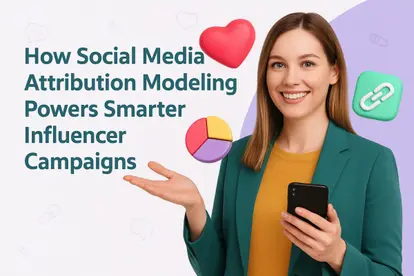What if your highest-performing influencer never gets credit in the report? What if the creator who sparked demand was cut from your next brief—because they didn’t drive the final click?
This is the disconnect driving a wave of frustration across marketing teams. In a media environment shaped by TikTok shares, private DMs, dark social loops, and multi-device behavior, attribution is no longer a clean science—it’s a strategic filter. Brands aren’t asking “Which ad converted?” anymore. They’re asking: Which creator moved the customer forward? And what signals can we actually trust?
Marketers know attribution is flawed, but they can’t ignore it—because it still determines budgets. Campaigns are becoming more multi-touch, creator-led, and channel-fragmented than legacy models can handle.
The solution isn’t to fix attribution. It’s to reframe how it powers influencer strategy—from briefing and budgeting to retention and rollout.
Modeling the Messy Middle
Influencer content doesn’t always drive instant clicks—but it often shapes long-tail behavior. Attribution modeling is what allows marketers to quantify that influence without relying solely on last-touch logic. For brands investing in multi-creator campaigns or UGC pipelines, it’s the only way to determine what’s working, even when you can’t fully see it.
Social media attribution modeling is rarely about precision—it’s about constructing decision-enabling frameworks in a fragmented, fast-moving media environment. Attribution is not a forensic tool to reconstruct exact customer journeys. It’s a probabilistic model designed to inform spend, signal content effectiveness, and optimize the touchpoint mix with directional accuracy.
Platform-side tracking, server-side APIs, and post-purchase survey data all fail in different but predictable ways. UTMs break across channels. Click-based models underrepresent brand building.
View-through conversions risk over-crediting exposure. Server-side pipelines introduce lag and loss. The takeaway isn’t to fix these systems—it’s to architect them with failure tolerance in mind.
Your goal is not to identify the single true touchpoint that converted a customer, but to weigh which parts of the journey actually mattered.
From Attribution to Briefing Strategy
For influencer marketers, attribution modeling should directly shape how briefs are scoped and creative is assigned. Attribution data should clarify which messages convert, which platforms contribute to progression, and where educational friction remains. If post-purchase sequences show users needed more clarity before buying, creators should be briefed to produce walkthroughs, reviews, or benefit-focused scripts—not another hook-led TikTok.
The strategic mistake many teams make is treating attribution models as postmortems. Instead, attribution should function as a planning asset. It should tell you where to dial up spend, not just where performance has already been observed.
That means resisting the urge to over-optimize based on platform-native reports and instead building comparative frameworks across multiple attribution views: platform-reported, third-party MTA, and macro-level benchmarking.
@maryannedamarzo 👀 You might be familiar with using Google/Facebook metrics to track your campaign’s performance. While they provide valuable insights, it’s better not to rely solely on their metrics 🙂 The reason I recommended using third-party pixels is that they are not tied to any specific platform. This allows you to have a more unbiased view of your data and make better decisions for your marketing strategy. #marketingmetrics #socialmediametrics #marketing #marketingstrategies #marketingdirector #adperformance #marketers
Driving Action Through Directional Insight
Directionality is key. When you see consistent lifts across brand search, direct traffic, and bottom-funnel CPMs during a TikTok or influencer-heavy push, you are likely capturing impact that attribution models don’t fully surface. Budget decisions shouldn’t be gated by the absence of 1:1 attribution.
Attribution modeling must embrace uncertainty—not to tolerate it, but to make high-confidence decisions despite it.
This shift allows brands to adopt “contribution-based” campaign reporting—where uplift in conversion paths is measured holistically, not piecemeal. This enables more informed decisions about which creators to retain, which formats to double down on, and which platform mix delivers compounding value across the funnel.
Signal Loss Across the Customer Journey
Influencer campaigns rarely live in the last click. Most operate upstream—generating interest, sparking discovery, and activating word-of-mouth before a user ever lands on a PDP. That means much of their impact never appears in traditional attribution models. To value creator contributions properly, marketers must factor in signal loss across the journey.
Marketers can no longer rely on clean, trackable clickstreams to tell the story of a buyer’s path to conversion. Instead, attribution modeling must account for the messy, nonlinear nature of modern customer journeys—especially in a social-first, multi-device, dark-funnel ecosystem.
Decision-making now often happens before users even enter a trackable environment. In B2B, this includes buyer committee discussions in Slack channels. In consumer contexts, it's WhatsApp threads, TikTok reposts via iMessage, or influencer content shared within private Instagram DMs.
@marketingoreo Measurement obsession is creating significant gaps in our marketing understanding. I recently observed a company significantly reduce their paid social budget after their last-click attribution model suggested Google search was driving all meaningful conversions. The pipeline showed a marked decline as a result. The reason was straightforward: social had been priming their audience before they searched, but this connection wasn't visible in their outdated attribution model. This pattern is more common than typically acknowledged: • 64% of marketing leaders express scepticism about their tracking data reliability • 42% of the buying decision process occurs before tracking systems detect intent • The average B2B buying committee consists of 5.4 stakeholders • Only 5% of your addressable market is actively purchasing at any given time Most prospect journeys happen in unmeasurable channels: private WhatsApp conversations, Slack communities, LinkedIn DMs, and professional networks where buyers exchange perspectives. This measurement gap is particularly evident in mature B2B categories with higher annual contract values. As sale complexity increases, attribution systems capture proportionally less of the complete journey. Practical approaches to address this: • Develop content that stimulates genuine conversation, reaching your ideal customer profile before active purchase intent • Implement intent-based and behavioural signals to help your sales team prioritise meaningfully engaged prospects • Utilise brand tracking metrics such as share of voice to better understand your brand's presence prior to measurable touchpoints • Account for what you can measure while acknowledging the limitations Marketing strategies that focus exclusively on immediate, attributable ROI often miss critical engagement points. Your brand exists in unmeasured spaces—in professional conversations and prospect consideration—long before formal engagement. Balance short-term metrics with long-term brand development. This isn't about abandoning measurement but rather complementing it with a more complete view of market engagement. #MarketingMetrics #B2BMarketing #AttributionBias #BrandVsPerformance #MarketingPsychology
These "invisible touches" don't register in pixels, CRMs, or UTM logs—but they play a material role in shaping brand perception and purchase consideration.
Making the Invisible Accountable
Dark social renders discount codes and swipe-up links increasingly irrelevant as performance indicators. Influencer managers must adopt attribution models that account for lagged effects, indirect sharing, and multi-exposure influence. Creators with content that travels peer-to-peer (via shares or screen recordings) often have deeper impact than their direct attribution data implies.
Attribution systems rooted in user-level digital interactions will always underreport these dark touchpoints. Yet, when spend is reallocated solely based on what’s measurable, marketers systematically devalue upper-funnel levers like awareness, affinity, and education—which frequently create demand long before clicks occur.
Solving for this requires a hybrid approach.
- First, treat lack of visibility as a strategic constraint, not a technical failure. Then, build models that include known blind spots. This could mean weighting certain channel mixes more heavily even in the absence of direct conversions.
- Second, integrate qualitative signals—like lift in branded search, increased retention, or organic creator amplification—as proxy indicators of influence.
Newer approaches include using server-side events paired with time-series analysis to isolate pre- and post-campaign shifts—especially helpful when content spreads in ways attribution tools can’t detect.
Tools like Triple Whale and Northbeam allow for tagging UGC-heavy campaigns to monitor lagged downstream behavior such as add-to-cart growth, subscriber rate lifts, or branded keyword spikes.
Dark social also increases the importance of top-level alignment between attribution windows and buying cycles. If your product has a 3-week consideration period, optimizing based on a 7-day click window will consistently under-credit the early-stage touchpoints that built intent.
Similarly, if a user first saw your product in a TikTok compilation but converted via a search ad days later, Last-Click attribution would misclassify that journey entirely.
To build attribution frameworks that reflect reality, you must consider not just how users convert, but how they behave. That means designing attribution systems that recognize indirect influence—especially in social environments where engagement ≠ intent, and intent ≠ conversion within a predictable time box.
Platform Attribution Is Designed to Serve the Platform
Attribution reports on Meta, TikTok, and YouTube aren't built to tell you the full truth—they’re built to validate ad spend within the platform. When you're running influencer campaigns that blend paid and organic reach, this becomes a major problem: you're not seeing influence, just conversion proximity. That distinction matters.
Platforms prioritize closed-loop attribution, which favors signals they can track directly—impressions, clicks, purchases within their walled gardens. But the minute a user leaves the app, switches devices, or gets nudged through off-platform behaviors (like Google search or peer-to-peer sharing), that trail breaks. The result: platform attribution becomes a self-reinforcing logic trap.
The Incentive Mismatch
The business model of each platform drives what it claims to “attribute.” For instance, TikTok's attribution analytics heavily favor in-app conversion actions and underweight downstream outcomes like email signups or search intent spikes.
Meanwhile, Meta’s default 7-day click / 1-day view model often inflates the contribution of low-consideration retargeting touchpoints. These aren’t bugs—they’re design choices.
This is especially problematic when you're briefing creators for blended campaigns: organic content amplified through Spark Ads or boosted via whitelisted creator handles. When performance is filtered through platform-native attribution, your campaign reports disproportionately credit impressions and CTRs—even if purchase behavior happened outside that ecosystem.
When working with Spark Ads on TikTok or Branded Content Ads on Meta, attribution skews toward engagement metrics like video views, retention, and in-app interactions. To avoid misattribution, supplement with post-campaign lift studies or external MTA (multi-touch attribution) tools like Rockerbox or Northbeam.
These help isolate true contribution by tracking cross-platform behavior beyond the walled garden.
When Attribution Becomes a Trap
The most dangerous outcome of trusting platform attribution blindly? Over-reinvestment in lower-funnel, high-visibility tactics—especially for influencers. Creators who generate engagement but not intent often appear more “efficient” than those sparking multi-touch behavior that escapes the platform’s tracking lens.
This can lead to performance distortion where clicky, trend-based influencer content is prioritized over deep storytelling or trust-building UGC. The latter may convert through branded search or email flows days later—but platforms won’t credit that, so it gets underfunded.
To correct for this, brands should implement “dual tracking”: comparing platform data to owned analytics (via Shopify post-purchase surveys, self-reported attribution checkboxes, or unique landing pages). Layering both helps identify which creators drive full-funnel action versus short-term engagement.
Single-Touch Models Are Simple—But Often Misleading
Simplicity has a cost. Single-touch attribution (first-click, last-click, or platform default) remains popular because it’s easy to implement, but for influencer campaigns, it's structurally flawed. These models reduce multi-step, multi-channel behaviors into a single source of truth—often misrepresenting how creators contribute to decision-making.
Single-touch setups ignore the way consumers bounce between platforms. A user may discover your product in an Instagram Story, hear about it again via a creator's YouTube review, then convert via TikTok ad days later. Under last-click, TikTok gets 100% of the credit—even if it was only the final nudge.
Common Pitfalls in Creator Attribution
Most brands still rely on promo codes or affiliate links for influencer tracking, which turns every campaign into a last-click trap. This penalizes creators who spark interest or consideration but don’t drive immediate action. In reality, strong creator content often accelerates intent—even if the purchase comes through a different path.
First-click attribution isn’t much better. It often overweights brand discovery moments without measuring whether the user would have converted without follow-up touchpoints. This distorts campaign learnings and leads to poor optimization: over-allocating budget to discovery creators while underfunding those driving deeper education or conversion readiness.
This distortion is particularly problematic in tiered influencer campaigns. A micro-influencer may introduce the brand with relatability, while a macro creator later validates it with authority. Single-touch models erase that nuance—and with it, the operational logic of your influencer funnel.
Making Single-Touch Work (When You Must)
Despite its limitations, some marketers must use single-touch models due to tooling constraints or reporting mandates. In these cases, adjustments are needed to minimize blind spots.
First, segment your creators by funnel stage before the campaign begins. Use single-touch attribution within each tier, not across the whole journey. This ensures performance isn’t benchmarked unfairly between creators with different roles. Second, run campaign pulses with varied CTA types—like “learn more” vs. “shop now”—to see which types of creators nudge progression even if they don’t close the sale.
When internal systems only support basic attribution, consider running short-term holdout tests. Temporarily pause certain creators or cohorts and monitor lift via branded search, return visits, or AOV changes. Even without full MTA, these deltas can reveal who’s moving the needle beyond what the single-touch model can see.
Multi-Touch Models Reveal Influence, Not Just Conversions
While single-touch attribution compresses the buyer journey into a false binary, multi-touch attribution (MTA) acknowledges how users move across platforms, creators, and content types before converting. For influencer marketers, this unlocks a more accurate view of contribution, not just conversion. But MTA only works when your data architecture and campaign logic support it.
Multi-touch models assign credit across multiple interactions, using frameworks like linear (equal credit), time-decay (more weight to recent), or position-based (most weight to first and last, less to middle). Each model serves different campaign goals. Linear works well when you want to measure consistent influencer support. Time-decay fits short cycles like product drops. Position-based fits hero-to-retargeting pipelines.
Mapping Touchpoint Sequences in Creator Campaigns
Influencer funnels aren’t linear—they’re layered. A creator might seed initial interest on TikTok, retarget followers on Instagram, and reinforce credibility on YouTube. Multi-touch modeling captures this full stack by attributing value to each touchpoint. Without this, you risk over-crediting whichever creator closed the sale—even if others did the heavy lifting.
MTA requires proper signal plumbing. You need clean UTM tracking, integrated pixels, server-side events, and CRM sync—especially when creators are involved in top-of-funnel and middle-funnel activation. Attribution tags must persist across redirects, mobile app transitions, and landing pages. Without this continuity, your MTA model will fragment and produce skewed results.
Tools like Triple Whale, Rockerbox, and Segment can streamline MTA implementation across influencer campaigns. When paired with unique link tracking per creator and funnel stage, they help isolate which creators generate additive value versus redundant spend.
Avoiding Over-Engineering
MTA is not plug-and-play. The risk of overfitting—attributing value where there’s just noise—is high when your campaign data is inconsistent. Misconfigured logic, lack of funnel tagging, or shallow sample sizes will invalidate your conclusions.
One workaround is using MTA in cohort analysis. Instead of obsessing over individual conversions, measure what happens when a creator cohort runs over a defined window (e.g., 14 days). Monitor lift in organic traffic, return sessions, and average order value. If these metrics improve across multiple MTA runs, the attribution pattern is validated.
Attribution Isn’t Accuracy—It’s Alignment
Attribution modeling won’t give you perfect answers—but it will give you better questions. For marketers managing influencer campaigns, UGC sprints, or multi-platform creator programs, attribution isn’t just a backend report—it’s a forward-looking strategy lever.
Whether you're briefing TikTok creators or optimizing Spark Ads, your goal isn't to trace a linear path to conversion. It's to understand which creators, channels, and content types are moving the customer forward—even if that movement happens off-platform, over time, or through dark social.
The real advantage isn’t in pinpointing a conversion—it’s in aligning spend, messaging, and creator formats around contribution signals. By shifting your attribution mindset from perfection to progression, you unlock smarter campaign structuring, more defensible budgets, and clearer creative direction.
Attribution, done right, becomes the connective tissue between creator execution and business outcomes. Not just a measurement tool—but a marketing multiplier.
Frequently Asked Questions
How does social listening complement attribution modeling in influencer campaigns?
Attribution models often miss off-platform sentiment shifts, making it essential to integrate social media listening insights to capture untagged mentions, emotional tone, and early demand signals.
Should attribution windows vary between always-on and burst influencer campaigns?
Yes—always-on vs. burst campaign structures require different attribution assumptions, as always-on builds gradual influence while bursts rely on compressed, short-cycle measurement.
How can scenario planning improve attribution-based decision making?
Running influencer scenario modeling helps test how different attribution setups affect projected outcomes, campaign ROI, and platform prioritization before launching.
How do Spark Ads affect attribution clarity in creator campaigns?
Spark Ads blur the lines between organic and paid performance, so understanding how Spark Ads collaborations function is critical to avoid misattribution between creator content and paid boosts.
Can attribution be localized for regional influencer strategies?
Yes, attribution models can adapt to local online marketing environments, accounting for geo-specific behavior patterns, platform usage, and conversion windows that vary by market.
How is AI changing attribution tracking in influencer marketing?
Modern AI-powered influencer platforms use predictive modeling and cross-channel stitching to identify probabilistic influence, even without direct links or visible conversions.
What tracking tech should be layered into creator campaigns?
Brands should evaluate dedicated influencer tracking platforms that offer UTM management, promo code segmentation, and server-side integration to reduce signal loss.
How should CPM elasticity factor into creator attribution?
Understanding influencer CPM elasticity helps marketers model diminishing returns and scale budgets more accurately when attribution shows marginal performance deltas across creator tiers.




